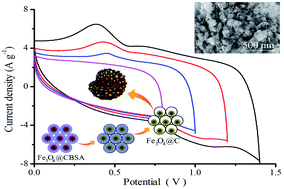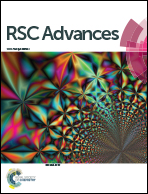Advanced asymmetric supercapacitors with a squirrel cage structure Fe3O4@carbon nanocomposite as a negative electrode
Abstract
Carbon materials have been used as negative electrodes for supercapacitor applications; nevertheless, owing to the low capacitance, they have limited ability to enhance the supercapacitor electrochemical properties. Here, we employ a facile chemical precipitation method for preparing a squirrel cage structure Fe3O4@carbon nanocomposite. In this architecture, the carbonized crosslinked bovine serum albumin (C) will play critical roles, serving as a skeleton for the deposition of Fe3O4 and a transportation pathway like “high-speed rail” for electrons, maintaining the structural stability as well as accommodating the volume expansion of Fe3O4 and facilitating electron transportation and the electrolyte ion diffusion. The iron oxide nanoparticles (Fe3O4) exhibit superior reversible redox characteristics, hence increasing the supercapacitor performance. Benefiting from a stable structure, an aqueous asymmetric supercapacitor using a CNT@Ni(OH)2 positive electrode (cathode) and Fe3O4@C negative electrode (anode) has also been assembled, which presents a high energy density of 17.3 W h kg−1 at a power density of 700 W kg−1. The strategy for choice of Fe3O4@C composites will provide new opportunities for future supercapacitors with superior cyclability and high power density.



 Please wait while we load your content...
Please wait while we load your content...